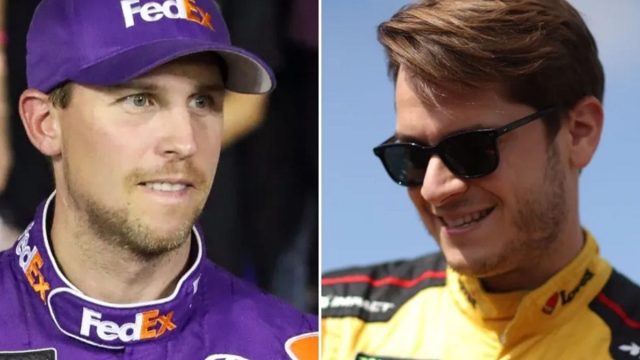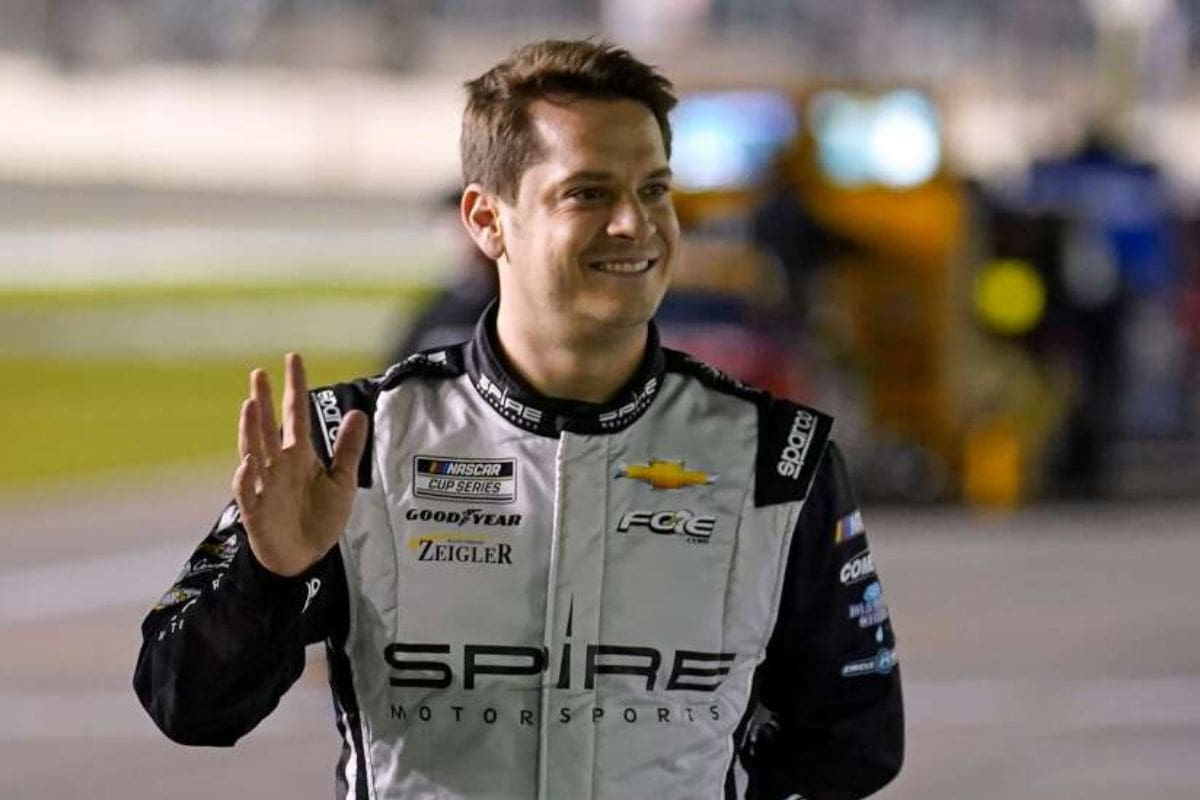Denny Hamlin Responds Strongly to Landon Cassill: Denny Hamlin‘s recent defense of his $18 million estimate for NASCAR team costs has ignited a notable dialogue within the racing community, particularly in response to Landon Cassill’s skepticism. Hamlin’s insistence on the necessity of this budget—excluding driver salaries and personnel expenses—raises critical questions about financial transparency and operational efficiency in the sport. As Cassill’s critique challenges established spending norms, it invites further examination of the underlying financial dynamics in NASCAR. What implications might this debate have for future team strategies and competitive balance?
Key Highlights
- Denny Hamlin asserts that $18 million is essential for a competitive NASCAR team, excluding driver salaries and personnel costs.
- Hamlin emphasizes the need for transparency in NASCAR’s financial operations, encouraging teams to share financial insights.
- Landon Cassill questions NASCAR’s spending practices, advocating for improved efficiency to enhance team profitability.
- NASCAR Insider supports Hamlin’s figures, suggesting a need for tactical spending to bolster competitiveness.
Initial Assertion and Challenge
Denny Hamlin’s assertion regarding the financial demands of fielding a competitive NASCAR team ignited a challenge from former driver Landon Cassill, who questioned the validity of the claimed $18 million expenditure. Cassill’s doubts reflects a broader conversation within the NASCAR community about financial transparency and the true costs of racing operations. His disagreement suggests that the current landscape may not necessitate such hefty investments, potentially indicating a disparity between perceptions and reality in team budgets.
Hamlin’s claim, as he told during a discussion with Kenny Wallace on the ‘Kenny Conversation’ platform, highlights a vital aspect of the sport: the noteworthy financial outlay required to remain competitive. By revealing a consensus with NASCAR on the matter, Hamlin emphasizes that the figures are not merely subjective estimates but rather grounded in collective acknowledgment from both teams and the governing body.
This dialogue raises questions about the sustainability of cost structures in NASCAR, particularly as teams navigate economic strains and competitive dynamics.
Cassill’s challenge serves to draw attention to the necessity for further dialogue regarding financial expectations in the sport. It opens the door to a critical examination of the operational costs that teams face, and whether the established financial benchmarks are indeed reflective of current realities.
Denny Hamlin’s Clarification
In view of the skepticism surrounding his financial claims, Hamlin clarified that the reported $18 million primarily encompasses the costs associated with fielding a racecar, excluding driver salaries and team personnel expenses. This delineation is significant as it provides a clearer understanding of the financial landscape in NASCAR, where many factors contribute to operational costs. Hamlin emphasized that this figure strictly pertains to the expenses incurred in maintaining a car for competition, highlighting the necessity of transparency in the sport.
“First, 18M is just for the car on the track to put on this show each and every week (NO driver) Seems as though you think it’s excessive. Well we (teams) opened our books to NASCAR to show what exactly that money was spent on and that it was not excessive. (Nas executives agreed) You mentioned that anything we make beyond 18m is “profit”. That would be incorrect. As someone who started a team from scratch and kept it as lean as I could, there are MANY other depts at a race team that are 💯 necessary to operate.”-(denny)
He further elaborated that perceptions of excessiveness in this budget are misguided, as NASCAR teams have voluntarily opened their financial books for scrutiny, demonstrating that their expenditures are justified and reasonable. Hamlin’s assertion, endorsed by NASCAR executives, highlights a collective acknowledgment of the realities of racing economics.
Well. Lots of thoughts.
First, 18M is just for the car on the track to put on this show each and every week (NO driver) Seems as though you think it’s excessive. Well we (teams) opened our books to NASCAR to show what exactly that money was spent on and that it was not… https://t.co/CW9gGvrdvz
— Denny Hamlin (@dennyhamlin) July 24, 2024
Moreover, he contested the notion that any revenue exceeding the $18 million threshold constitutes pure profit. Hamlin pointed out that a myriad of fundamental functions—ranging from business operations to marketing and sponsorship—demand substantial financial investment. Each department plays a key role in not only sustaining the team but also in fostering growth within the sport itself through diverse activation strategies.
“Business, marketing, sponsorship, social media, it goes on and on. That all cost a significant amount of money that is above and beyond the numbers listed above. That money is spent as not only as a necessity for our team but to GROW the sport thru on and off the track activation. Hopefully this is helpful when debating this topic,” -(hamlin)
Hamlin’s insights serve as an important reminder of the complexities involved in running a racing team, emphasizing that financial success is intricately tied to extensive operational costs rather than simplistic profit margins. This clarification aims to enrich the ongoing discourse about NASCAR’s economic framework.
Cassill’s Argument and NASCAR Insider’s Viewpoint
Cassill’s argument highlights a critical tension within NASCAR regarding operational expenditures, suggesting that teams could improve profitability by reevaluating their spending practices. By referencing Denny Hamlin’s claim that $18 million is necessary to field a competitive car, Cassill contends that the current financial model encourages excess rather than efficiency. His assertion that teams are not mandated to hire extensive engineering staff, utilize private travel, or invest heavily in equipment presents a compelling case for a shift in expenditure priorities.
The implications of Cassill’s critique extend beyond individual team finances; they challenge the overarching culture in NASCAR that equates success with lavish spending. As Cassill points out, many teams may not be using their resources effectively, potentially limiting their competitiveness and profitability. This perspective resonates with a growing need for financial prudence in a sport where operational costs can spiral out of control.
A NASCAR Insider supporting Hamlin’s financial estimation and advocating for a procurement model akin to those employed in other major sports leagues, such as the NFL, NBA, and MLB. This alignment suggests a broader industry acknowledgment that NASCAR may benefit from adopting more tactical spending frameworks.
In this situation, the dialogue initiated by Cassill serves not only as a critique but also as a catalyst for potential reform, urging teams to reassess their financial strategies for sustainable growth and success within the sport.
Brett Griffin’s Perspective and Denny Hamlin’s Standings
While Brett Griffin raises valid concerns about the financial dynamics within NASCAR, Denny Hamlin’s current position in the Cup Series standings highlights the complex interplay between talent acquisition and budget constraints in the sport.
“Money over talent until we pay the teams to hire talent. The Xfinity Series is slowly being ruined and, in time, Cup will be next. Anyone who doesn’t see the progression and where it’s headed is BLIND. NFL teams don’t have to sign a new sponsor to hire the best QB that’s a free agent.”-(brett)
Griffin’s assertion that financial considerations overshadow talent in driver recruitment points to a troubling trend within NASCAR, where the competition for sponsorship can dictate team composition. This reality is particularly relevant given Hamlin’s fourth-place standing, showcasing both his ability and the resources available to him.
Money over talent until we pay the teams to hire talent. The Xfinity Series is slowly being ruined and, in time, Cup will be next.
Anyone who doesn’t see the progression and where it’s headed is BLIND.
NFL teams don’t have to sign a new sponsor to hire the best QB that’s a… https://t.co/0zhXe5cwNC
— Brett Griffin (@SpotterBrett) July 24, 2024
Hamlin’s success is indicative of how elite drivers can utilize their talent to attract sponsorship, yet it also emphasizes the inherent disadvantages faced by less-funded teams. The ramifications of this financial disparity are noteworthy:
- Talent Drain: Established drivers often secure lucrative contracts, limiting opportunities for emerging talent.
- Competitive Imbalance: Teams with deeper pockets can consistently outperform those operating on tighter budgets.
Hamlin’s position serves as both a reflection of individual skill and a reminder of the systemic challenges within NASCAR. As the sport evolves, addressing these financial disparities will be essential in preserving the competitive spirit that attracts fans and fuels driver aspirations.
News in Brief: Denny Hamlin Responds Strongly to Landon Cassill
The discourse surrounding NASCAR team costs highlights critical financial dynamics within the sport.
Denny Hamlin’s defense of the $18 million figure, excluding driver salaries and personnel expenses, emphasizes the complexities of operational budgeting.
While Landon Cassill’s skepticism invites scrutiny of spending practices, it also opens avenues for dialogue on enhancing financial efficiency.
Ultimately, the exchange demonstrates the necessity for transparency and informed discussions to promote competitiveness in an evolving racing landscape.
ALSO READ: Denny Hamlin’s Brickyard 400 Victory Hopes Dashed After the Multi-car Wreck



